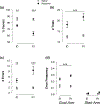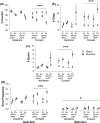Flexible spatial learning requires both the dorsal and ventral hippocampus and their functional interactions with the prefrontal cortex
- PMID: 32077554
- PMCID: PMC7731996
- DOI: 10.1002/hipo.23198
Flexible spatial learning requires both the dorsal and ventral hippocampus and their functional interactions with the prefrontal cortex
Abstract
When faced with changing contingencies, animals can use memory to flexibly guide actions, engaging both frontal and temporal lobe brain structures. Damage to the hippocampus (HPC) impairs episodic memory, and damage to the prefrontal cortex (PFC) impairs cognitive flexibility, but the circuit mechanisms by which these areas support flexible memory processing remain unclear. The present study investigated these mechanisms by temporarily inactivating the medial PFC (mPFC), the dorsal HPC (dHPC), and the ventral HPC (vHPC), individually and in combination, as rats learned spatial discriminations and reversals in a plus maze. Bilateral inactivation of either the dHPC or vHPC profoundly impaired spatial learning and memory, whereas bilateral mPFC inactivation primarily impaired reversal versus discrimination learning. Inactivation of unilateral mPFC together with the contralateral dHPC or vHPC impaired spatial discrimination and reversal learning, whereas ipsilateral inactivation did not. Flexible spatial learning thus depends on both the dHPC and vHPC and their functional interactions with the mPFC.
Keywords: executive function; hippocampus; learning; memory; prefrontal cortex; spatial memory; temporal lobe.
© 2020 Wiley Periodicals, Inc.
Conflict of interest statement
CONFLICT OF INTEREST
The authors declare they have no conflicts of interest.
Figures





References
-
- Apergis-Schoute J, Pinto A, & Paré D (2006). Ultrastructural organization of medial prefrontal inputs to the rhinal cortices. The European Journal of Neuroscience, 24, 135–144. - PubMed
-
- Bannerman DM, Deacon RMJ, Offen S, Friswell J, Grubb M, & Rawlins JNP (2002). Double dissociation of function within the hippocampus: Spatial memory and hyponeophagia. Behavioral Neuroscience, 116, 884–901. - PubMed
-
- Bannerman DM, Rawlins JN, McHugh SB, Deacon RMJ, Yee BK, Bast T, … Feldon J (2004). Regional dissociations within the hippocampus—Memory and anxiety. Neuroscience and Biobehavioral Reviews, 28, 273–283. - PubMed
-
- Bannerman DM, Yee BK, Good MA, Heupel MJ, Iversen SD, & Rawlins JN (1999). Double dissociation of function within the hippocampus: A comparison of dorsal, ventral, and complete hippocampal cytotoxic lesions. Behavioral Neuroscience, 113, 1170–1188. - PubMed
Publication types
MeSH terms
Grants and funding
LinkOut - more resources
Full Text Sources
Miscellaneous

